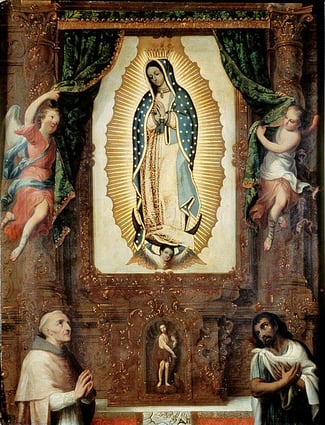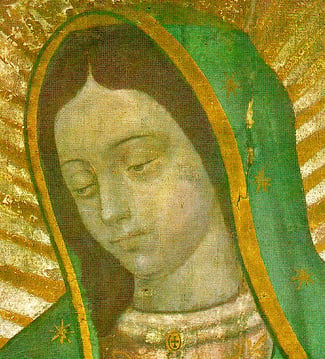In the early sixteenth century, a boy named Cuauhtlatoatzin (meaning “singing eagle”) was raised in the Aztec religion. He later learned about God from a group of Franciscan missionaries and converted to the Catholic Church in 1524.
 Altarpiece of the Virgin of Guadalupe with Saint John the Baptist, Fray Juan de Zumárraga and Juan Diego by Miguel Cabrera / Public domain, via Wikimedia Commons
Altarpiece of the Virgin of Guadalupe with Saint John the Baptist, Fray Juan de Zumárraga and Juan Diego by Miguel Cabrera / Public domain, via Wikimedia Commons
Later, to be known as Juan Diego, he would take a familiar path to continue growing in the religion he had converted into. During these walks, in 1531, Juan Diego would receive a life-changing miracle—a miracle that is forever linked to the biggest source of conversion in North America.
Juan Diego’s Marian Apparition
On December 9, 1531, the Blessed Virgin Mary appeared to a native Aztec, Juan Diego. She asked him to go to his bishop, Bishop Juan de Zumarraga, and ask him to build a church on Tepeyac Hill. After telling Bishop Zumarraga, Zumarraga did not believe him, but the Blessed Virgin appeared to Diego that very same day and, yet again, asked him to return to his Bishop with the request.
Upon asking the Bishop again, Bishop Zumarraga still hesitated and asked Diego to return with a sign. Sadly, before Diego could return to the hill, Diego’s uncle fell very ill. On December 12th, the Blessed Virgin appeared to him in the street, promising that if he returned to the hill, he would receive a sign and that his uncle would be completely healed. Following her instructions, Diego returned to the hill, where he found Castilian roses growing (not native to Mexico). Diego gathered the roses, put them in his tilma, and returned to Bishop Zumarraga. When he opened his cloak and the roses fell to the ground, the picture of the Lady of Guadalupe appeared on the tilma. The evidence of the roses and image was enough to convince the bishop to build the first church atop Tepeyac Hill.
The Miraculous Tilma
 Photograph of an Image of the Tilma of Our Lady of Guadalupe / Public domain, via Wikimedia Commons
Photograph of an Image of the Tilma of Our Lady of Guadalupe / Public domain, via Wikimedia Commons
The image of Our Lady of Guadalupe itself has many extraordinary attributes that border on the miraculous and could very probably be verified as miracles. Five attributes were scientifically tested in the 20th and 21st centuries:
- Most replicas of tilmas only last approximately fifteen years before decomposition begins, yet for almost 500 years, the tilma has maintained its chemical and structural integrity. Even more amazing is the fact that the tilma was on display without protective measures for its first 115 years and was subjected to soot, candle wax, incense, and touching throughout its history. Currently, there is no scientific evidence as to how the tilma has kept its integrity
- While there have been painted additions to the tilma (e.g. the moon underneath the Virgin’s feet, the angel holding the cloth, and the rays coming from the image), the original image seems to have been painted in a single step as there are no sketches underneath, corrections, or even brush strokes.
- According to Nobel Prize-winning biochemist Richard Kuhn, who analyzed a sample of the fabric, the pigments used are from no known natural source, whether animal, mineral, or vegetable. Given that there were no synthetic pigments in 1531, this enigma remains inexplicable.
- Dr. Philip Serna Callahan noted that the original image on the tilma has not cracked, flaked, or decayed over 500 years, while the paint and gold leaf have flaked or deteriorated considerably. This phenomenon has not yet been scientifically explained.
- The eyes of the Virgin have three remarkable qualities that could not have been achieved with the technology of 1531 and would not even be able to be achieved through today’s technological advancements:
- Engineer Jose’ Aste Tonsmann has amplified an image of the pupils of the Blessed Virgin 2,500 times and can identify not only what appears to be the image of Bishop Zumarraga but also several other witnesses of the miracle reflected within them.
- The images in the pupils also manifest the triple reflection called the Samson-Purkinje effect—which was completely unknown at the time of the image’s formation.
- The image in the Virgin's eyes follows the curvature of the cornea precisely in the way it occurs in a normal human eye.
Juan Diego is Made a Saint
After his encounter with the Blessed Virgin, Juan Deigo lived a life of devotion to the Church and spreading her message. He died in 1548 and was buried in the first chapel dedicated to the Virgin of Guadalupe.
On May 6th, 1990, Pope John Paul II beautified Juan Diego in the Basilica of Santa Maria di Guadalupe, Mexico City.
In 2002, Pope John Paul II was also the one to proclaim him a saint. Juan Diego is now known as the patron saint of indigenous people.
Lessons from St. Juan Diego
St. Juan Diego inspires us to be bold in our faith and not shy away from sharing it.
The Blessed Virgin appeared to Juan Diego during his normal routine, and she entrusted him with a mission that required him to be strong in his faith and persistent in his path. His action inspires us to remain steadfast in our faith—and know that even when we shy away from it, God will continue to invite us to grow closer to Him (like the Blessed Virgin appearing to Juan Diego when he took another path to avoid her).
We must remember that in spreading the love of God—and the teachings of the Church—our voice may be bigger and more impactful than we may ever fully comprehend.
May Juan Diego light a path for you to be as faithful and bold as you can be.
*Originally published on December 9, 2022.

